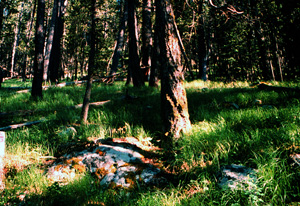Community Field Guide
Scientific Name:
Abies lasiocarpa / Calamagrostis rubescens Forest
Common Name:
Subalpine fir / pinegrass Forest
Community Description
Summary:
This predominantly large patch to matrix type forest association of the Interior West is found at the warm, dry limits of the Abies lasiocarpa series, from northern Montana east of the Continental Divide southward to the mountain ranges of northern Utah. At the northern extreme of its distribution it is found as low as 4,900 to over 6,300 feet and at the southern distribution limits it ranges from 6,900 to over 9,000 feet; generally it is not aspect restricted. Abies lasiocarpa is the indicated climax dominant (see Comments heading) but seldom is a stand dominant, an expression usually exhibited by Pinus contorta or Pseudotsuga menziesii, Pinus contorta. In its typical expression, in young and open stands, the undergrowth is a luxuriant sward of Calamagrostis rubescens and Carex geyeri with scattered forbs and shrubs.
Environment: This type usually grades to Abies lasiocarpa / Arnica cordifolia or Abies lasiocarpa / Thalictrum occidentale on cooler exposures and to Pseudotsuga menziesii, Pinus contorta / Carex rubescens on warmer more exposed sites. It exists in complex mosaics with Abies lasiocarpa / Carex geyeri that occasion the question as to what factors may differentiate these types.
In particular regions (sometimes individual mountain ranges) this association can show aspect dependency, occurring predominantly on west- and east-facing slopes of Montanaís Rocky Mountain Front, as well as expressing the same preferences in Utahís Wasatch Range (Mauk and Henderson 1984). It is common on the south-facing flank of the Centennial Range but is considerably less prevalent on the north-facing flank. In other mountain ranges it is present on all aspects and positions including dry steam terraces and valley floors, however, it is more typically a type of upper slopes and ridges. It also shows no particular substrate preference and occurrs on all variety of granitics, extrusive volcanics (including basalt, rhyolite and trachyte), sedimentaries (sandstone, limestone) and metamorphics (quartzite, schist). An exception would seem to be fine-grained, noncalcareous sedimentary types, from which it has not been documented.
Vegetation:
Most descriptions of this type come from mid-seral stands that have a mixed canopy dominance divided between Pseudotsuga menziesii, Pinus contorta and Pinus contorta. Abies lasiocarpa and Picea engelmannii are slow to reestablish on these dry sites. Pinus albicaulis occurs scattered at the highest elevations of this type while on the warmest sites, particularly those of calcareous substrates, Pinus flexilis can be a minor to appreciable component. The undergrowth is typically dominated in younger open stands by a near sward of Calamagrostis rubescens, usually accompanied by Carex geyeri, and the forbs, Thalictrum occidentalis, Fragaria virginiana, Antennaria racemosa, Aster conspicuus and Arnica cordifolia are characteristically present though poorly represented, with the exception of Arnica cordifolia. In older stands or those in the "closed canopy" stage Carex rubescens may be reduced to scattered patches or even poorly represented. In open canopy seral conditions Shepherdia canadensis and Juniperus communis may be well represented.
Range:
Abies lasiocarpa / Calamagrostis rubescens is a common type from central Montana (Pfister et al. 1977), where it occurs on calcareous substrates, to northern Utah (Mauk & Henderson 1984) and central Colorado (Karmokova et al. 1988). It occurs as far west as the eastern flank of the Cascades in Washington and Oregon (Williams and Smith 1990, Williams and Lillybridge 1985) and is prevalent in Oregonís Blue Mountains (Johnson & Simon 1987).
Global Rank: G4G5 State Rank: S3
Community References
Identifier:
CEGL000301
Author:
01-03-16 / S. V. Cooper, MTNHP
Citations:
Brotherson 1987, Cooper et al. 1987, Johnson and Simon 1987, Komarkova 1982, Komarkova et al. 1988, Mauk and Henderson 1984, Pfister et al. 1977, Steele et al. 1981, Steele et al. 1983, Williams and Lillybridge 1985, Williams and Smith 1990, Williams et al. 1990
View Detailed Citation Information | New Community Search | NatureServe Explorer Community Information
This information is from the:
Montana Natural Heritage Program
Montana State Library--Natural Resource Information System
1515 East Sixth Ave., Helena, MT 59620-1800
406 444-3989
mtnhp.org
mtnhp@mt.gov






